A letter from Serbia
Last year, pupils of primary a school in Kragujevac experienced the program. Here is their account.
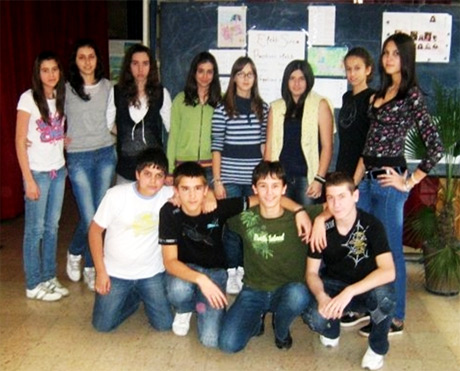
In late May 2009, the pupils from the primary school Milutin and Draginja Todorovic from Kragujevac, a town in central Serbia, joined the project Living with the Sun. This is one of the subjects proposed by the « Hands in pastry » project, lead by professor Stevan Jokic in Serbia.
Kragujevac is a town with the population of 250000, 120 kilometres far from Belgrade. There are 800 pupils in our school, one of the biggest in the centre of the town, on the bank of river Lepenica.
Together with 20 pupils of the 7th grade, members of the “Physics and biology lovers”, Verica Pavic, biology teacher and Natasa Milinkovic, physics teacher, worked on the project. The task was to confirm the existence of the UV-radiation to determine when the intensity of the radiation is the biggest, how a man can protect himself from the UV-radiation and what the effects of that radiation are.
First group
The pupils had a task to expose the papers sensitive to UV-rays to natural and artificial light.The time of exposure was 5 and 10 minutes.
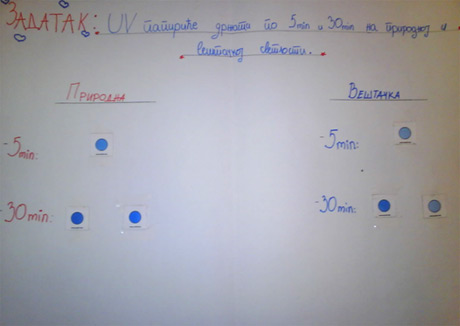
Second group
The pupils had to measure the length of the shadow at a particular time – 10h,12h,14h,16h – and to expose the UV paper to sunlight for 30 minutes in that place.The results were presented in tables.
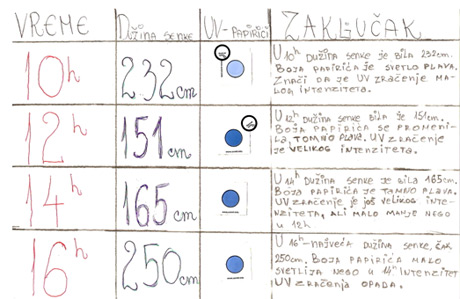
We can see from the tables the times of measurements,the length of the shadow and the conclusion depending on the time of the measurement.
Conclusion: the shorter the shadow, the closer we are to the Sun’s noon, when the intensity of the UV radiation is the biggest.That’s what we should take into account when exposing to sun’s rays during the summer. When the shadow is shorter than a person’s height, you should get out of the Sun, because the UV-radiation is intensive.
Third group
They had a task to check the influence of some kinds of protection to the UV- radiation, and what the best protection from the UV-rays is. The UV paper was covered with different materials to see their influence to the UV-radiation intensity.The results are presented in the picture where we can see the sort of the material, the time of exposure,the colour of the UV paper and the conclusion.
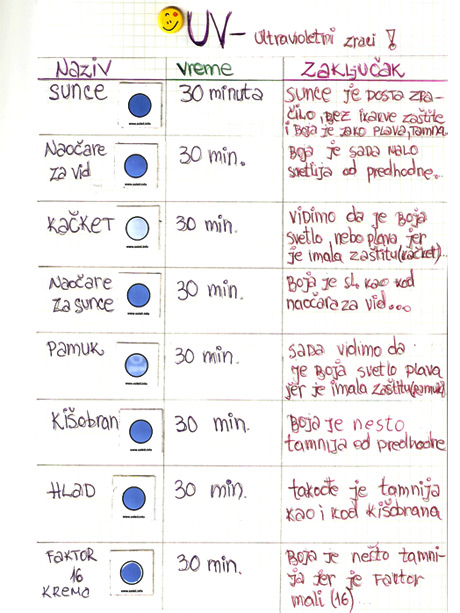
Conclusion: Different materials have different effects on the UV radiation intensity. From the experiment we can see that a cap and cotton are the best protection,which means that they let the least UV rays pass through.Some kind of sunglasses are not good for the Sun,we should also take that into account,and the creams with the low SPF are not efficient. During the summer people should wear cotton clothes with long sleeves, sunglasses, a hat -this is the conclusion.
The fourth group had a task to mention all the effects of the Sun’s radiation, positive and negativefor the living world.
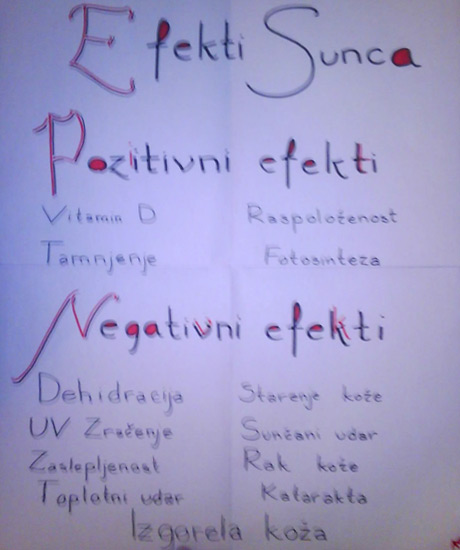
Positive effects: creating of vitamin D,skin darkening,mood, photosynthesis.
Negative effects are: dehydration, UV-radiation, blindness, heat stroke, Sun stroke, skin’s getting old, cataract and burnt skin.
The pupils used available literature, textbooks, magazines, internet. It was very interesting and funny during the work, they easily came to the conclusions. They made an exhibition of their work in the school hall to remind other pupils of the danger that long-lasting exposure to the Sun brings.
Since the theme is current and interesting, pupils made a presentation from the best works called “Living with the Sun” in order to get more pupils acquainted with the effects of the Sun’s radiation. “Prevention team” will use the presentation. It functions in our school with an aim to educate pupils and to get them familiar with addiction diseases, proper nutrition and from the beginning of this school year with the problems that exposure to the Sun causes.The team consists of the school teachers who are interested in particular themes.
If we obtain UV papers, it will be more interesting that pupils by themselves come to the specific conclusions and to include much more pupils in the project next year providing that they can make experiments by themselves.
Verica Pavic, biology teacher
Natasa Milinkovic, physics teacher
Primary School “ Milutin and Draginja Todorovic”, Kragujevac, Serbia.


